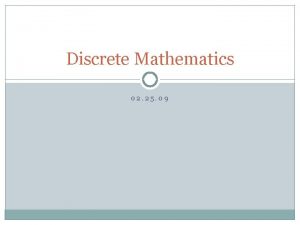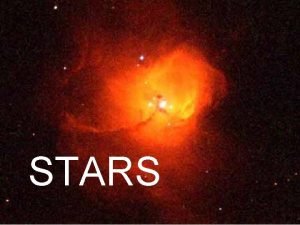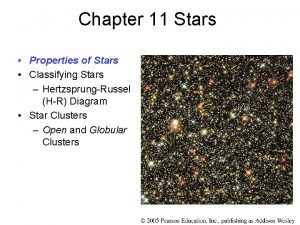Classification of stars How many different types of






















- Slides: 22

Classification of stars How many different types of stars do you know? What properties make them fall into different groups?

Classification of Stars - Apparent and Absolute Magnitude The most important factor in knowing what type of star you are observing is understanding its Luminosity is a measure of the Output of a star in Watts This can be measured using just the visual spectrum or the total output (bolometric)

Fusion Remember that the output from a star is due to Nuclear Fusion reactions in the core and in Main Sequence stars this is due to Hydrogen being fused into Helium. Understanding these processes enables an astronomer to understand how different types of stars occur.

Calculating luminosity Unfortunately to measure the luminosity of a star you must know its distance away. For relatively close stars the best method is parallax measurements. Place an object at one side of the classroom. Using only a ruler, large piece of paper and a protractor estimate the distance to the object without walking over to it

https: //vimeo. com/41434123

Stellar parallax The Earth orbits the sun at a If the angle p is measured 150 in distance of approximately radianskm. and. If the line is million youbase observe 1 astronomical unitour orbit nearby stars during (1 AUa =6 150 million km)they over month period appear to distance move relative then the d will to be the distant, in fixed background calculated parsecs: stars.

Units of distance in Astrophysics

Astronomical Distance examples Pleiades is an open star cluster visible as the "Seven Sisters" by the naked eye. Distance - 130 pc

Astronomical Distance examples Betelgeuse is a super red giant in Orion Distance - 197 pc

Units of distance in Astrophysics The star Alapha Centauri is 4. 351 light years from the solar system. Calculate it’s parallax in radians and arcsec. 0. 75 arcseconds 3. 6 x 10 -6 radians

Milky Way Galaxy • The main (90% of stars) part of our galaxy is about 40, 000 ly across • The entire radius is about 100, 000 ly across

Andromeda Galaxy Andromeda is our nearest large spiral galaxy. It is 2. 5 million light years away

Hipparcos The smallest parallax Hipparcos could measure was 0. 002” Determine the distance to the furthest star that Hipparcos can measure Accurately in parsecs and LY

Gaia https: //www. youtube. com/watch? v=o. Gri 4 YNggoc

Magnitudes of Stars (The Hipparcos scale) • Star magnitudes first star measured by Hipparcos Sirius is the were brightest with visual in 102 BC m of -1. 46 at a distance from Earth magnitude • The early magnitude scale of only 8. 6 went ly from 1 - 6 (as integers) and were from Bright to Dim • The modern scale uses this scale but it has been extended, especially in the region of very faint objects. It also now has a mathematical description which means that it is a continuous measurement as opposed to being discrete. This has caused very bright objects to have a negative visual magnitude!


Apparent and Absolute Magnitude • The magnitudes that have been discussed so far are the apparent magnitudes which means that this is how bright the objects appear from Earth • To compare one star to another you must have a standardised method of comparing them. This is done by calculating what their magnitude would be if you were 10 parsecs from it; their absolute magnitude • The human eye perceives that a magnitude 1 star is about 100 times brighter than a magnitude 6 star. Therefore a logarithmic scale of base 2. 51 is appropriate:

Apparent and Absolute Magnitude • This means that a star that is one magnitude (absolute) brighter than another star is actually 2. 51 times brighter than it • Remember brighter objects have lower magnitudes • Calculating the absolute magnitude M of a star from it's apparent magnitude m and distance D (in parsecs) is done using this formula: Note that there are various ways of writing this formula so you may get a different form in the exam

Example calculation Spica is 67 pc away and has an apparent magnitude of m = 1. 0 what is it's absolute magnitude?

Linking Luminosity to Temperature The actual flux of energy from a star can be calculated. Stefan's law links Temperature of a star to it's Luminosity (in Watts)

Extension • It is possible to convert absolute magnitudes of stars in Luminosity values in Solar units using the formula below however this is not on the A-level course.

Summary • Luminosity is one of the most important variables that must be known for a star • The brightness of a star is known as its magnitude: – Apparent magnitude is a measure of how bright a star appears from Earth – Absolute magnitude is how bright a star would look if the observer was 10 pc from it • Absolute magnitude can be calculated using the following formula: • Luminosity and the temperature of a star are linked via the Stephan-Boltzmann formula
 There are three sizes of schnauzer dog
There are three sizes of schnauzer dog Green number
Green number How many different types of bread are there
How many different types of bread are there Talk about your favourite tv programme
Talk about your favourite tv programme Types of stars
Types of stars Types of stars
Types of stars Thermosoftening plastics examples
Thermosoftening plastics examples Flame test principle
Flame test principle Sound will travel at different speeds in different mediums.
Sound will travel at different speeds in different mediums. Sound travels fastest through
Sound travels fastest through Different culture have different moral codes
Different culture have different moral codes Different angle different story
Different angle different story Acids and bases song lyrics
Acids and bases song lyrics Manufactured boards examples
Manufactured boards examples Things that make us different
Things that make us different Venn diagram different same different
Venn diagram different same different How many different rocks are there
How many different rocks are there The logical view of a database:
The logical view of a database: Lots of sports
Lots of sports Language
Language Operating in the markets of many different countries
Operating in the markets of many different countries How many different sets of
How many different sets of How many different three-letter initials can people have?
How many different three-letter initials can people have?











































